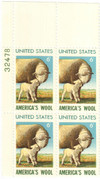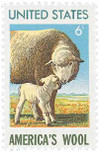
1971 6c America's Wool Industry
# 1423 - 1971 6c America's Wool Industry
$0.35 - $150.00
U.S. #1423
6¢ American Wool Industry
Issue Date: January 19, 1971
City: Las Vegas, NV
Quantity: 136,305,000
Printed By: Bureau of Engraving and Printing
Printing Method: Lithographed and engraved
Perforations: 11
Color: Multicolored
Used in Europe since 10,000 B.C., wool was first brought to the Americas in 1521, by Hernando Cortez. This stamp celebrates the 450th anniversary of this event.
U.S. #1423
6¢ American Wool Industry
Issue Date: January 19, 1971
City: Las Vegas, NV
Quantity: 136,305,000
Printed By: Bureau of Engraving and Printing
Printing Method: Lithographed and engraved
Perforations: 11
Color: Multicolored
Used in Europe since 10,000 B.C., wool was first brought to the Americas in 1521, by Hernando Cortez. This stamp celebrates the 450th anniversary of this event.











